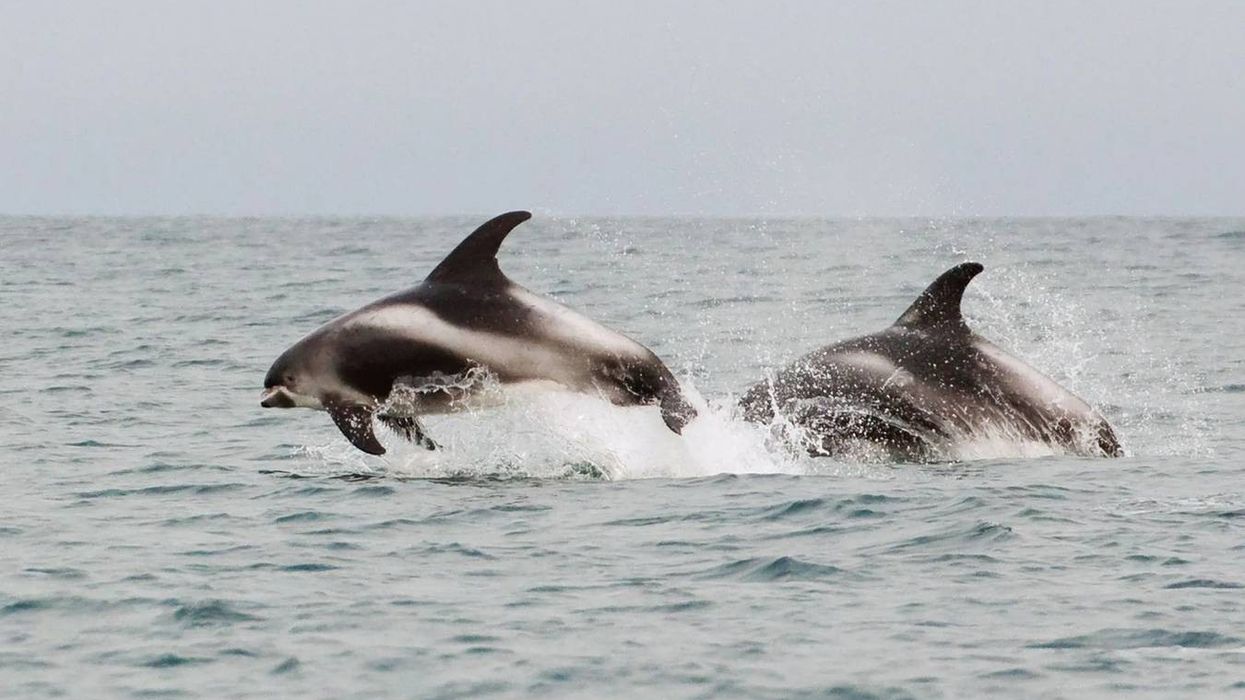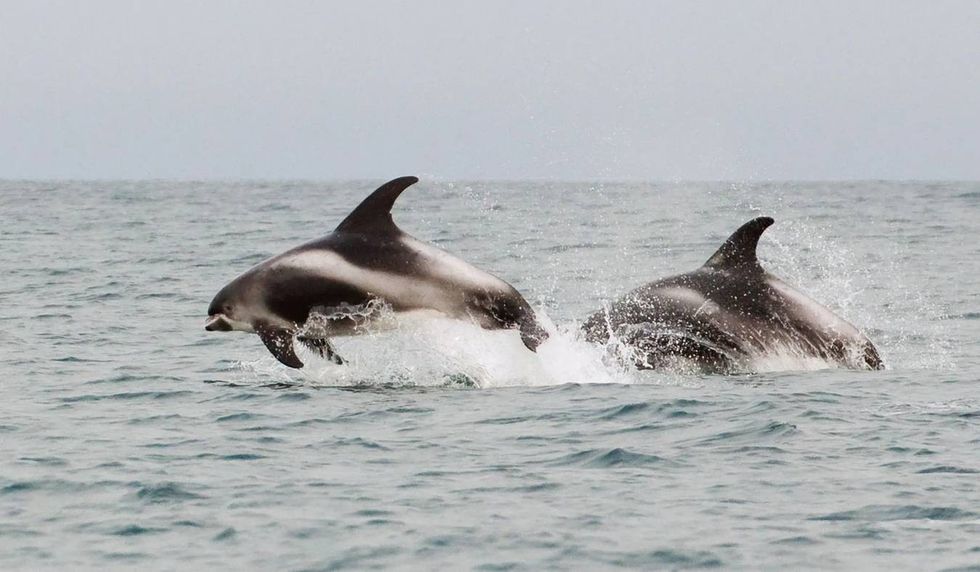The white-beaked dolphin (Lagenorhynchus albirostris) belongs to the Delphinidae family of marine animals. These white-beaked dolphins have dark gray and black bodies without any hair and a tall curved dorsal fin to swim.
Dolphins of this species love to ride on the bow waves of speeding boats. They do this not only because of the water force but also because they are highly curious about human behaviors. This is when many onlookers can spot them jumping over the water surface.
Many people in Canada call these white-beaked dolphins 'dolphin squidhound' mainly because the white-beaked dolphin diet consists of squids and shrimps. However when a study on the life of this dolphin was conducted in the Netherlands, scientists discovered around 25 different species in their stomachs.
You can say that these mammals feed on many different small marine animals that they can find near them.
Read on to know more interesting facts about white-beaked dolphins. To read about some other similar species, check our articles on black dolphins and Atlantic spotted dolphins.
White-Beaked Dolphin Interesting Facts
What type of animal is a white-beaked dolphin?
White-beaked dolphins are marine dolphins that belong to the Delphinidae family of animals.
What class of animal does a white-beaked dolphin belong to?
The white-beaked dolphin belongs to the Mammal class of animals. They are one of the largest species that belong to the Lagenorhynchus genus of animals.
How many white-beaked dolphin is there in the world?
Based on the white-beaked dolphin population records, we know that there are at least 100,000 across the world.
Where does a white-beaked dolphin live?
White-beaked dolphins are found in the cold and subpolar waters of the North Atlantic Ocean. The cold-temperate waters of the North American and European regions like Massachusetts, Scandinavia, and the United Kingdom are highly suitable for the population of this species.
What is a white-beaked dolphin's habitat?
The North Atlantic white-sided dolphin population prefers a cold water range. The most favorable white-beaked dolphin habitat is focused around the North Atlantic waters. These Atlantic white-sided dolphins are known to migrate to the southern regions during the spring and summer months.
Who does the white-beaked dolphin live with?
White-beaked and white-sided dolphins are a highly social species. They are known to roam around in their groups of either 30 to several hundred dolphins. The largest group ever recorded consisted of 1500 white-beaked dolphins together in the water. Groups of dolphins are called pods.
How long does a white-beaked dolphin live?
These gray, white-beaked dolphins, like other dolphins, may have a life expectancy of around 40 years. Their exact life expectancy is unknown. River dolphins, on the other hand, can live for 30 years if they remain disease-free.
How do they reproduce?
These dolphins reach sexual maturity between 6-10 years of age. The females are known to mature two years earlier than the males. Their mating season occurs during the summer months that range between May and September.
After mating, the females go through a gestation period of around 11 months and birth a baby calf. As the gestation period is 11 months, this species engages in mating immediately after giving birth.
What is their conservation status?
The International Union for Conservation of Nature (IUCN) has marked this species of white-beaked dolphins under the Least Concern category in their Red List.
White-Beaked Dolphin Fun Facts
What does the white-beaked dolphin look like?
As the name suggests, this species of white-beaked dolphins has a short white beak. Even though their whole body is dark gray or blackish in color, the sides and underparts do have a few white patches along with the white beak. These white patches usually extend on their backs behind the dorsal fin.
This species has a large and curved dorsal fin with flanks on the upper body. These dolphins habe around 25 or 28 teeth on each jaw, although the teeth are not seen due to the gums.
They also have 92 vertebrae. The males and females look alike and can be distinguished only with the help of their sizes. The females are usually smaller than the males.

How cute are they?
Regardless of their different species, dolphins are all considered cute mainly due to their active social behavior and intelligence.
How do they communicate?
White-beaked dolphins communicate with the echo or sonar waves in the water. When in social groups of several hundred individuals moving together, they also use their social whistle to communicate.
How big is a white-beaked dolphin?
White-beaked dolphins have a length and weight range that is 10 times bigger than Hector's dolphins. The white-beaked dolphin size ranges between 110 in (2.8 m) and 122 in (3.1 m).
How fast can a white-beaked dolphin swim?
Even though the marine population of these dolphins is considered slow compared to other species, they are known to swim with a speed of 30.6-45 kph (19-28 mph).
How much does a white-beaked dolphin weigh?
The Lagenorhynchus albirostris species is long and weighs around 400-770 lb (180-350 kg).
What are the male and female names of the species?
Lagenorhynchus albirostris, or white-beaked dolphin's common name, is a sex-neutral term used for males and females. You can distinguish them apart with the help of their size as males are larger than females.
What would you call a baby white-beaked dolphin?
Just like other dolphins, a baby white-beaked dolphin is called a calf too.
What do they eat?
White-beaked dolphins feed on benthic crustaceans, fish, shrimps, cod, herrings, and other marine animals. As these white-beaked dolphins are social, they are often observed hunting for their food along with the fin, humpback, and killer whales.
Are they dangerous?
There haven't been any dangerous encounters recorded about the white-beaked dolphin in the UK, North America, or other regions.
Would they make a good pet?
Even though these white-beaked dolphins are quite social in their mannerisms, there haven't been enough records about them being kept as pets.
Did you know...
Even though groups of these dolphins are called pods, large groups with only males are also called a party or an alliance.
Why is it called a white-beaked dolphin?
The term 'albirostris' is translated as a 'white-beak', based on this dolphin's distinctive appearance its white-beak feature. This is why they were named white-beaked dolphins.
Why are white-beaked dolphins endangered?
Even though these white-beaked dolphins have a conservation status of Least Concern, they are considered endangered. This is mainly because of hunting and commercial activities that happen in these water bodies.
These dolphins get caught in trawl nets and gillnets. Oil and toxic substances also spill into the ocean water, causing a large majority of this species to be harmed. Additionally, as this species communicates with sound waves, if there is noise in the marine surroundings, their hearing aid is highly likely to be harmed, further harming their lives.
Here at Kidadl, we have carefully created lots of interesting family-friendly animal facts for everyone to discover! For more relatable content, check out these Ganges River dolphin facts or Fraser's dolphin facts!
You can even occupy yourself at home by coloring in one of our free printable dolphin coloring pages.
Second image by Hannah Beker









